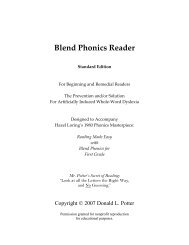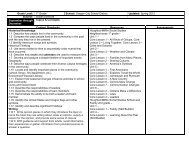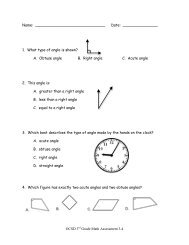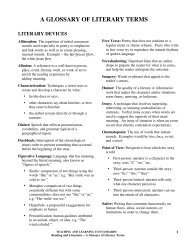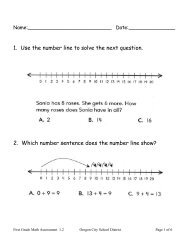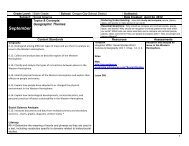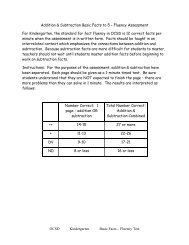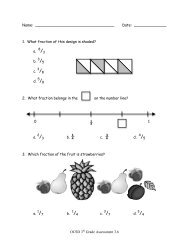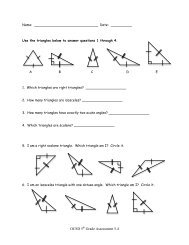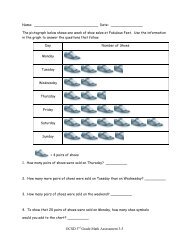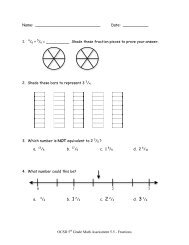Sixth Grade Curriculum Map (PDF) - Oregon City School District
Sixth Grade Curriculum Map (PDF) - Oregon City School District
Sixth Grade Curriculum Map (PDF) - Oregon City School District
Create successful ePaper yourself
Turn your PDF publications into a flip-book with our unique Google optimized e-Paper software.
RH.7 Integrate visual informationWritingWH.4 Produce clear and coherent writingin which the development, organization,and style are appropriate to task,purpose, and audience.WH.5 With some guidance and supportfrom peers and adults, develop andstrengthen writing as needed by planning,revising, editing, rewriting, or trying a newapproach, focusing on how well purposeand audience have been addressed.WH.6 Use technology, including theInternet, to produce and publish writingand present the relationships betweeninformation and ideas clearly andefficiently.WH.10 Write routinely over extendedtime frames (time for reflection andrevision) and shorter time frames (a singlesitting or a day or two) for a range ofdiscipline-specific tasks, purposes, andaudiences.2
<strong>Grade</strong>Level:Subject:Topics &Concepts:Cultures-Behind thecultureAztec,Maya, Inca,Inuit6 th <strong>School</strong>: <strong>Oregon</strong> <strong>City</strong> <strong>School</strong> <strong>District</strong> Updated: Spring 2012Social ScienceEnduring Understanding:Social scientists recognize and analyze multiple points of view to explain the ideas and actions of individuals and groups.Essential Questions: How can differing points of view affect relations between and within societies? Why should we recognize andanalyze multiple points of view? Why should we care about the perspectives of others?Content Standards Resources ASSESSMENTWorld Book OnlineHistorical Knowledge6.1 Determine and explain the historical context of key people,cultures, products, events, and ideas over time including theexamination of different perspectives from people involvedincluding, but not limited to, Aztec, Maya, Inca, Inuit…**This is PART of the Standard.Historical Thinking6.4 Explain how different cultures in the Western Hemisphererecord history.6.7 Define and use the terms “decade,” “century,” and“millennium,” and compare alternative ways that historicalperiods and eras are designated by identifying the organizingprinciples upon which each is based.Civics and Government6.17 Compare and contrast early forms of government via thestudy of early civilizations (tribal, monarchy, democracy,theocracy, and oligarchy) in the Western Hemisphere.Social Science Analysis6.23 Interpret documents and data from multiple primary andsecondary sources (art, artifacts, …real or simulated historicalsites…)*.*This is PART of the Standard.LiteracyRH.4 Determine the meaning of words and phrases as theyare used in a text, including vocabulary specific to domainsrelated to history/social studies.RH.5 Describe how a text presents informationRH.7 Integrate visual informationWebForms of Governmenthttp://www.mrsoshouse.com/puzpro/compcongovern.htmlhttp://ofcn.org/cyber.serv/academy/ace/soc/cecsst/cecsst088.htmlMayan, Aztec, Inca, Inuit websiteshttp://www.lessonpathways.com/Pathways/Detail/17376/the-mayanshttp://www.lessonpathways.com/Pathways/Detail?path=%2f03_History%2fYear_5_History_Guided_Journey%2f02Native_People_of_the_Northhttp://www.lessonpathways.com/Pathways/Detail?path=%2fUser%3aLoliveras%2fNative_People_of_the_South%2fInca_Empirehttp://incas.mrdonn.org/index.htmlhttp://aztecs.mrdonn.org/index.htmlhttp://mayas.mrdonn.org/index.htmlhttp://ms-andersonoceanlake.wikispaces.com/*Social+Studies3
WritingWH.4 Produce clear and coherent writing in which thedevelopment, organization, and style are appropriate to task,purpose, and audience.WH.5 With some guidance and support from peers andadults, develop and strengthen writing as needed byplanning, revising, editing, rewriting, or trying a newapproach, focusing on how well purpose and audience havebeen addressed..WH.6 Use technology, including the Internet, to produce andpublish writing and present the relationships betweeninformation and ideas clearly and efficiently.WH.10 Write routinely over extended time frames (time forreflection and revision) and shorter time frames (a singlesitting or a day or two) for a range of discipline-specific tasks,purposes, and audiences.4
<strong>Grade</strong> Level: 6 th <strong>School</strong>: <strong>Oregon</strong> <strong>City</strong> <strong>School</strong> <strong>District</strong> Updated: Spring 2012Subject: Social ScienceNovemberTopics & Concepts: Major Explorers andColonizers of Countries in WesternHemisphere, and the ColumbianExchangeEnduring Understanding: Social scientists examine cause and effect to seerelationships between people, places, ideas, and events.Essential Questions: Why are social scientists concerned about cause and effect?How can examining cause and effect help us understand relationships between people,places, ideas, and events?Content Standards Resources ASSESSMENTTextbookHoughton Mifflin: Social Studies-World Cultures &Geography pg. 310-313Historical Knowledge6.1 Determine and explain the historical context of keypeople, cultures, products, events, and ideas over timeincluding the examination of different perspectives frompeople involved including, but not limited to, .., majorexplorers, colonizers of countries in the Western Hemisphere,and the Columbian Exchange. **This is PART of the Standard.Historical Thinking6.8 Analyze cause-and-effect relationships, including theimportance of individuals, ideas, human interests and beliefs.6.9 Differentiate between fact and interpretation in historicalaccounts and explain the meaning of historical passages byidentifying who was involved, what happened, where ithappened, and relating them to outcomes that followed andgaps in the historical record.Social Science Analysis6.23 Interpret documents and data from multiple primary andsecondary sources (… eyewitness accounts, letters anddiaries, …).*This is PART of the Standard.LiteracyRH.1 Cite specific textual evidence to support analysis ofprimary and secondary sources.RH 3 Identify key steps in a text’s description of a processrelated to history/social studies.RH.4 Determine the meaning of words and phrases as theyare used in a text, including vocabulary specific to domainsrelated to history/social studies.RH.5 Describe how a text presents informationRH.7 Integrate visual informationWebhttp://ms-andersonoceanlake.wikispaces.com/*Social+StudiesColumbian Exchangehttp://msh.councilforeconed.org/lessons.php?lid=68379Explorershttp://jsdlib.jsd.k12.ca.us/Explorers.htm5
WritingWH.2 Write informative/explanatory texts, including thenarration of historical events, scientific procedures/experiments, or technical processes.a) Introduce a topic clearly, previewing what is tofollow; organize ideas, concepts, and informationinto broader categories as appropriate toachieving purpose; include formatting (e.g.,headings), graphics (e.g., charts, tables), andmultimedia when useful to aiding comprehension.b) Develop the topic with relevant, well-chosen facts,definitions, concrete details, quotations, or otherinformation and examples.c) Use appropriate and varied transitions to createcohesion and clarify the relationships amongideas and concepts.d) Use precise language and domain-specificvocabulary to inform about or explain the topic.e) Establish and maintain a formal style andobjective tone.f) Provide a concluding statement or section thatfollows from and supports the information orexplanation presented.WH.4 Produce clear and coherent writing in which thedevelopment, organization, and style are appropriate totask, purpose, and audience.WH.5 With some guidance and support from peers andadults, develop and strengthen writing as needed byplanning, revising, editing, rewriting, or trying a newapproach, focusing on how well purpose and audience havebeen addressed..WH.6 Use technology, including the Internet, to produceand publish writing and present the relationships betweeninformation and ideas clearly and efficiently.WH.10 Write routinely over extended time frames (time forreflection and revision) and shorter time frames (a singlesitting or a day or two) for a range of discipline-specifictasks, purposes, and audiences.6
<strong>Grade</strong> Level: 6 th <strong>School</strong>: <strong>Oregon</strong> <strong>City</strong> <strong>School</strong> <strong>District</strong> Updated: Spring 2012Subject:Social ScienceTopics & Concepts: Major Explorers andDecemberColonizers of Countries in WesternHemisphere and Columbian ExchangeEnduring Understanding:Essential Questions:Content Standards Resources AssessmentsContinuation of November Standards7
<strong>Grade</strong> Level: 6 th <strong>School</strong>: <strong>Oregon</strong> <strong>City</strong> <strong>School</strong> <strong>District</strong> Updated: Spring 2012Subject: Social ScienceTopics & Concepts: Rise and Fall ofAncient Civilizations in Europe,Enduring Understanding: Social scientists analyze and recognize howpeople, places, and ideas change over time.JanuaryAsia and AfricaEssential Questions: How can people, places, and ideas change overtime?How have the actions, ideas, and values of people changed over time?How can the study of history helps us connect continuity and change?Content Standards Resources ASSESSMENTTextbook:Houghton Mifflin: Social Studies-WorldCultures & Geography: Chapter 15, unit 6, pg292-297Historical Knowledge6.3 Describe the rise; the political, technological, and culturalachievements; and the decline of ancient civilizations inEurope, Asia, and Africa prior to the Roman Empire.Historical Thinking6.5 Critique information to determine if it is sufficient toanswer historical questions.LiteracyRH.4 Determine the meaning of words and phrases as theyare used in a text, including vocabulary specific to domainsrelated to history/social studies.RH.5 Describe how a text presents informationRH.7 Integrate visual informationWritingWH.4 Produce clear and coherent writing in which thedevelopment, organization, and style are appropriate totask, purpose, and audience.WH.5 With some guidance and support from peers andadults, develop and strengthen writing as needed byplanning, revising, editing, rewriting, or trying a newapproach, focusing on how well purpose and audiencehave been addressed..WH.6 Use technology, including the Internet, to produceand publish writing and present the relationships betweeninformation and ideas clearly and efficiently.WH.10 Write routinely over extended time frames(time for reflection and revision) and shorter timeframes (a single sitting or a day or two) for a range ofdiscipline-specific tasks, purposes, and audiences.GlencoeWorld History: Journey Across Time (7 th grade)pg. pg.8-15, pg. 17-23, pg. 26-30, pg. 38-67, pg.444-476http://medievaleurope.mrdonn.org/lessonplans.htmlhttp://www.studenthandouts.com/World_History/Units/09.04/01.Outlines-PowerPoints.htmhttp://edsitement.neh.gov/lesson-plan/noteveryone-lived-castles-during-middle-ages- sectquestionshttp://china.mrdonn.org/lessonplans.htmlhttp://www.nationalarchives.gov.uk/documents/education/medieval-cartoon.pdfhttp://www.studenthandouts.com/World_History/worldhistory09section16.htmhttp://africa.mrdonn.org/lessonplans.html8
<strong>Grade</strong> Level: 6 th <strong>School</strong>: <strong>Oregon</strong> <strong>City</strong> <strong>School</strong> <strong>District</strong> Updated: Spring 2012Subject:Social ScienceTopics & Concepts: Rise and Fall ofFebruaryAncient Civilizations in Europe, Asiaand AfricaEnduring Understanding:Essential Questions:Content Standards Resources AssessmentsContinuation of February Standards9
<strong>Grade</strong> Level: 6 th <strong>School</strong>: <strong>Oregon</strong> <strong>City</strong> <strong>School</strong> <strong>District</strong> Updated: Spring 2012Subject: Social ScienceTopics & Concepts: Native American Enduring Understanding: Social scientists recognize and analyze multiple pointsof view to explain the ideas and actions of individuals and groups.MarchEssential Questions: Why should we recognize and analyze multiple points ofview?Why should we care about the perspectives of others?Content Standards Resources AssessmentsHistorical Knowledge6.1 Determine and explain the historical context of keypeople, cultures, products, events, and ideas over timeincluding the examination of different perspectives frompeople involved including, but not limited to, early NativeAmerican cultures of North America.*This is PART of the Standard.6.6 Create and compare timelines that identify major people,events and developments in the history of individualcivilizations and/or countries that comprise the AmericasLiteracyRH.1 Cite specific textual evidence to support analysis ofprimary and secondary sources.RH.3 Identify key steps in a text’s description of a processrelated to history/social studies.RH.4 Determine the meaning of words and phrases as theyare used in a text, including vocabulary specific to domainsrelated to history/social studies.RH.5 Describe how a text presents informationRH.7 Integrate visual informationRH.8 Distinguish among fact, opinion, and reasonedjudgment in a text.RH.9 Analyze the relationship between a primary andsecondary source on the same topic.RH.10 By the end of grade 8, read and comprehendhistory/social studies texts in the grades 6–8 text complexityband independently and proficiently.Webhttp://ms-andersonoceanlake.wikispaces.com/*Social+Studieshttp://www.academicamerican.com/colonial/topics/nativeam.htmhttp://www.pbs.org/teachers/connect/resources/2812/preview/http://www.pbs.org/teachers/connect/resources/7021/preview/http://www.lessonpathways.com/Pathways/Detail?path=%2f03_History%2fYear_5_History_Guided_Journey%2f02Native_People_of_the_Northhttp://exploringafrica.matrix.msu.edu/teachers/curriculum/m7b/activity1.phphttp://www.teachervision.fen.com/nativeamerican-heritage-month/teacherresources/6648.html10
WritingWH.2 Write informative/explanatory texts, including thenarration of historical events, scientific procedures/experiments, or technical processes.a) Introduce a topic clearly, previewing what is tofollow; organize ideas, concepts, andinformation into broader categories asappropriate to achieving purpose; includeformatting (e.g., headings), graphics (e.g.,charts, tables), and multimedia when useful toaiding comprehension.b) Develop the topic with relevant, well-chosenfacts, definitions, concrete details, quotations,or other information and examples.c) Use appropriate and varied transitions tocreate cohesion and clarify the relationshipsamong ideas and concepts.d) Use precise language and domain-specificvocabulary to inform about or explain the topic.e) Establish and maintain a formal style andobjective tone.f) Provide a concluding statement or section thatfollows from and supports the information orexplanation presentedWH.4 Produce clear and coherent writing in which thedevelopment, organization, and style are appropriate totask, purpose, and audience.WH.5 With some guidance and support from peers andadults, develop and strengthen writing as needed byplanning, revising, editing, rewriting, or trying a newapproach, focusing on how well purpose and audiencehave been addressed..WH.6 Use technology, including the Internet, to produceand publish writing and present the relationships betweeninformation and ideas clearly and efficiently.WH.10 Write routinely over extended time frames (time forreflection and revision) and shorter time frames (a singlesitting or a day or two) for a range of discipline-specifictasks, purposes, and audiences.11
<strong>Grade</strong> Level: 6 th <strong>School</strong>: <strong>Oregon</strong> <strong>City</strong> <strong>School</strong> <strong>District</strong> Updated: Spring 2012Subject:Social ScienceTopics & Concepts: Native AmericaEnduring Understanding:AprilEssential Questions:Content Standards Resources AssessmentsContinuation of February Standards12
<strong>Grade</strong> Level: 6 th <strong>School</strong>: <strong>Oregon</strong> <strong>City</strong> <strong>School</strong> <strong>District</strong> Updated: Spring 2012Subject:Social ScienceTopics & Concepts: In depth study of aWestern Hemisphere issue of ahistorical eventMayEnduring Understanding: Social scientists find theconnections between events of the past and present to helpunderstand our world.Essential Questions: How can studying the past help usunderstand the present world and the future?How can the study of history help us compare and contrastthe relationship between the past and present?Content Standards Resources AssessmentsHistorical Knowledge6.2. Identify examples of the social, political, cultural, and economicdevelopment in key areas of the Western Hemisphere6.10. Identify issues related to a historical event in the Americas and give basicarguments for and against that issue utilizing the perspectives, interests andvalues of those involved.Social Science Analysis6.20. Critique information to determine if it is sufficient to answer questions.6.21. Clarify key aspects of an event, issue, or problem through inquiry andresearch.6.22. Gather, interpret, document, and use information from multiple sources,distinguishing facts from opinions and recognizing points of view.LiteracyRH.1 Cite specific textual evidence to support analysis of primary andsecondary sources.RH.3 Identify key steps in a text’s description of a process related tohistory/social studies.RH.4 Determine the meaning of words and phrases as they are used in a text,including vocabulary specific to domains related to history/social studies.RH.5 Describe how a text presents informationRH.7 Integrate visual informationRH.9 Analyze the relationship between a primary and secondary source on thesame topic.WritingWH.4 Produce clear and coherent writing in which the development,organization, and style are appropriate to task, purpose, and audience.WH.5 With some guidance and support from peers and adults, develop andstrengthen writing as needed by planning, revising, editing, rewriting, or tryinga new approach, focusing on how well purpose and audience have beenaddressed..WH.6 Use technology, including the Internet, to produce and publish writinghttp://www.besthistorysites.net/13
and present the relationships between information and ideas clearly andefficiently.WH.7 Conduct short research projects to answer a question (including aself-generated question), drawing on several sources and generatingadditional related, focused questions that allow for multiple avenues ofexploration.WH.8 Gather relevant information from multiple print and digital sources,using search terms effectively; assess the credibility and accuracy of eachsource; and quote or paraphrase the data and conclusions of others whileavoiding plagiarism and following a standard format for citation.WH.9 Draw evidence from informational texts to support analysis,reflection, and research.WH.10 Write routinely over extended time frames (time for reflection andrevision) and shorter time frames (a single sitting or a day or two) for a rangeof discipline-specific tasks, purposes, and audiences.14
<strong>Grade</strong> Level: 6 th <strong>School</strong>: <strong>Oregon</strong> <strong>City</strong> <strong>School</strong> <strong>District</strong> Updated: Spring 2012Subject:Social ScienceTopics & Concepts: Current forms ofJunegovernment and economics in theWestern HemisphereEnduring Understanding:Essential Questions:Content Standards Resources AssessmentsCivics and Government6.18 Describe current forms of government in countries in the WesternHemisphere.Economics/Financial Literacy6.19 Describe the role and function of prices in the economy.LiteracyRH.1 Cite specific textual evidence to support analysis of primary andsecondary sources.RH.3 Identify key steps in a text’s description of a process related tohistory/social studies.RH.4 Determine the meaning of words and phrases as they are used in a text,including vocabulary specific to domains related to history/social studies.RH.5 Describe how a text presents informationRH.7 Integrate visual informationWritingWH.4 Produce clear and coherent writing in which the development,organization, and style are appropriate to task, purpose, and audience.WH.5 With some guidance and support from peers and adults, develop andstrengthen writing as needed by planning, revising, editing, rewriting, or tryinga new approach, focusing on how well purpose and audience have beenaddressed..WH.6 Use technology, including the Internet, to produce and publish writingand present the relationships between information and ideas clearly andefficiently.WH.10 Write routinely over extended time frames (time for reflection andrevision) and shorter time frames (a single sitting or a day or two) for a rangeof discipline-specific tasks, purposes, and audiences.NOTE: WH.3 is not addressed in the social studies/literacy standard15



